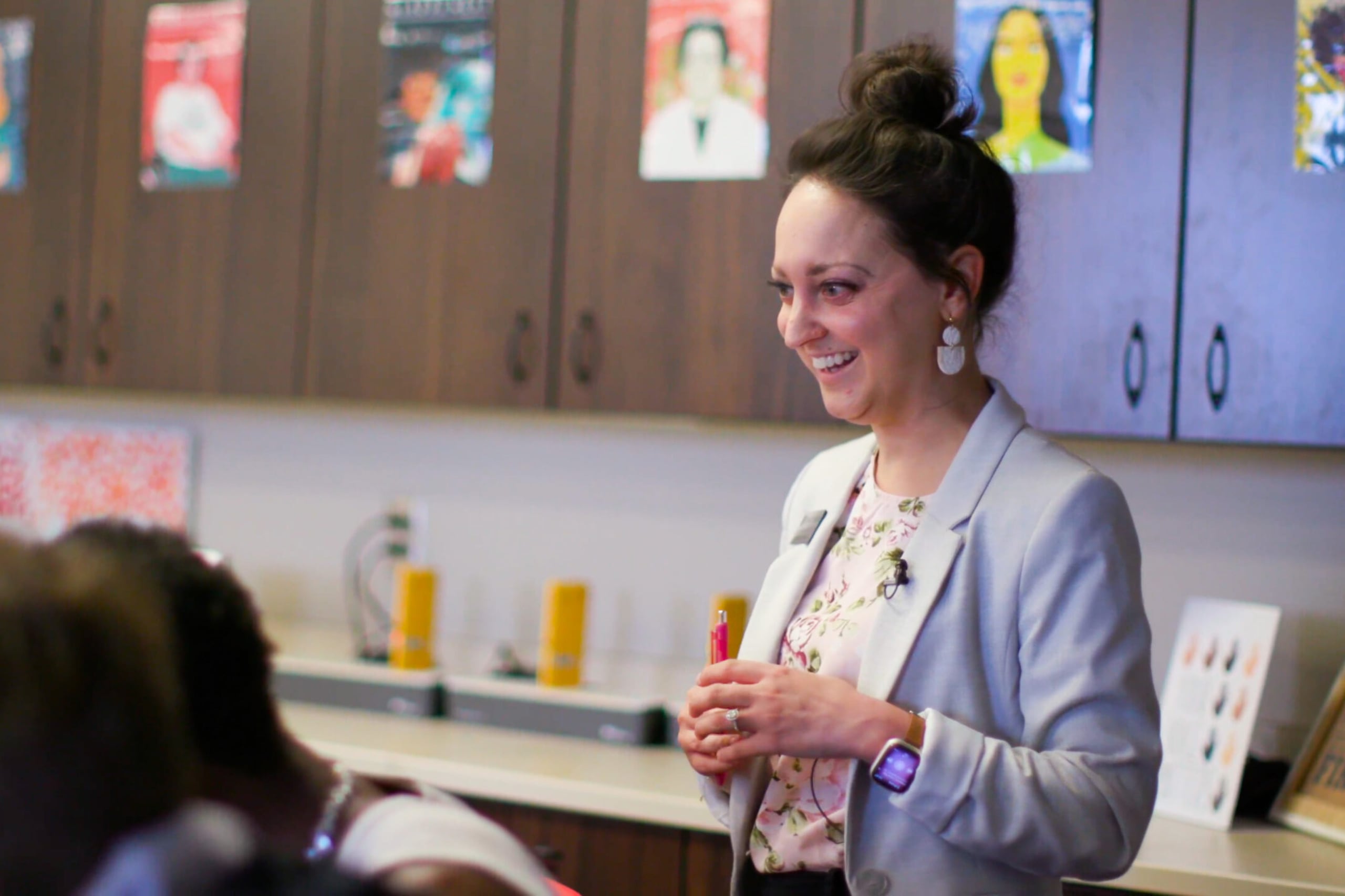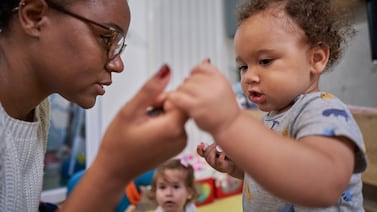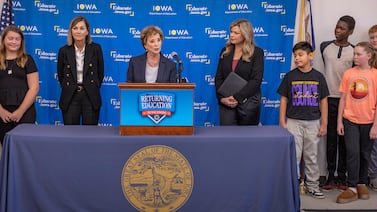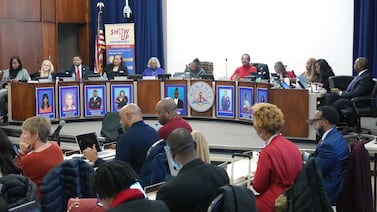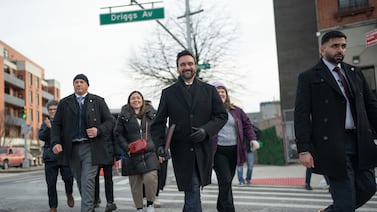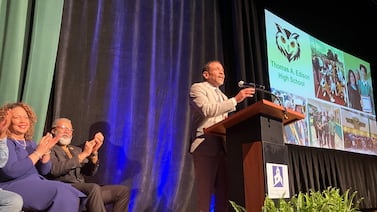Six years ago, teacher Rebecka Peterson started spending a lot of extra time sitting and listening to her students.
Peterson, who teaches math at Union High School in Tulsa, Oklahoma, and was named the National Teacher of the Year on Wednesday, starts off the school year by sharing personal successes and struggles with her students. That includes what it was like to grow up as an immigrant of Swedish-Iranian descent who moved around a lot as a kid and got teased when she was learning to speak English.
Then she meets with each of her students over the course of several weeks, inviting them to tell her about whatever they’d like for at least 15 minutes. Peterson credits the exercise with helping more students pass her calculus class.
“I learned to show up, to receive whatever they entrusted to me,” Peterson wrote in her Teacher of the Year application. “Their stories brought me to my knees — nearly every student had undergone some form of adversity or trauma, often more monumental than anyone realized.”
Like many math teachers, Peterson knows what it’s like to fill in gaps for her students who missed out on instruction during the pandemic. But COVID teaching has stuck around in other ways for her, too.
When many of her calculus students were learning virtually in fall of 2020, Peterson created over 100 video lessons that allowed students to watch her solve problems, then stop to answer problems on their own. Before she went on sabbatical this year, Peterson was still assigning her students those videos to watch at home so they could spend more time in class working on problems together.
“I do math with them, not at them,” she wrote.
After news of her award broke, Chalkbeat spoke with Peterson about why math gets a “bad rap,” how she checks in on her students’ mental health, and why knowing more about her students helps her be a more patient teacher.
This interview has been lightly edited for length and clarity.
I wanted to start by asking you about what it means to be honored as a high school math teacher. Math has been getting so much attention in the news right now as being something a lot of kids are struggling with. How might you add to the conversation, especially at a time when the country is paying close attention to how high schoolers are doing in math?
Math can get kind of a bad rap sometimes. For me, and every mathematician I know, mathematics is so beautiful. When we really get into the rhythm of it, we’re transported. But I think, oftentimes, there is so much content to teach, and our kids don’t get to feel that. That’s a conversation that I think we need to be having, about making sure that our teachers have the time and space to be able to showcase what math really is all about — which is creativity and collaboration and problem-solving.
The Gates Foundation, for example, did this study that showed a lot of folks think that math needs to be more relevant and tied to what students can see in the real world. [The Bill and Melinda Gates Foundation is a supporter of Chalkbeat.] As a calculus teacher, do you feel like you need to make your math more relevant for your students?
The beautiful thing about calculus is it is so ubiquitous. We use it to figure out the average value of a Bitcoin over the last month, or model population growth, or if I’m drinking a cup of coffee right now, with my caffeine tolerance, when will my body allow me to fall asleep? I’m very lucky in that calc is already so applicable.
But I’m all for creating more pathways for our students to be able to see that application earlier on. We’ve had this track of Algebra I, Geometry, Algebra II, since I think 1892. It’s time to explore some more math pathways for our students so that they truly all feel like they are mathematicians. Because that is what I believe to my core — that every person is a math person.
You teach at a large urban high school, and many of your students come from low-income backgrounds. In your own math classrooms, how has the pandemic affected what you need to do for them and what they may be struggling with?
Kids have changed since the pandemic. There is this fascinating study out of Stanford. It suggests that perhaps we are now teaching an entire generation of students whose brains have been rewired a bit. And I think that we can’t ignore that.
For me, it’s really important that I connect to my students, that my students feel connected to me, and they feel connected to each other. That looks like teaching my students breathing techniques so they have that in their toolkit when they start to feel dysregulated. Doing gratitude journaling, helping them be the author of their own stories, and doing mental health check-ins — these small daily acts we do as teachers to open space for our students to be vulnerable allows them to know that we’re on their side and that we have been through a lot.
One of your teaching approaches is that you often ask students to share more about their backgrounds with you so that you can create that connection. Can you tell me more about why that’s been an effective tool for you in math?
With math, it can be a very intimidating subject for students. I have to push them pretty hard to do some really quite rigorous mathematics. If I am going to be able to do that, then they have to trust me. They have to know that I am on their side, that I’m not going to ask them to do something that they can’t eventually accomplish. That starts with being real and being vulnerable with them.
The first day of school, I share stories — both joys and sorrows — of my life. I think every single high schooler, at some point, has felt like an outsider. For me, it’s important to share those moments where I felt like an outsider, so that they understand that I know what that’s like, and I don’t want them to ever feel that in our space.
Then I just welcome them to come share their story. They’re invited to sign up for 15-minute time slots — before school, after school, during lunch — to tell me whatever they want. We talk about their family, their pets, their jobs, their clubs, their background with math and with school. Especially post-pandemic, those are heavy weeks. It’s a lot to sit with over 100 stories one-on-one. And it takes about 10 weeks to sit with every student, but once those 10 weeks are over, there is just this palpable change in the classroom.
Can you say more about that?
When I learn their story, I’m softened, and it empowers me to elevate their voice, and it empowers me to work even harder on their behalf because I know where they’re coming from. I think it makes me more patient. I come to the understanding that oftentimes a behavior that I’m not in love with in the moment is because there is a deeper story going on.
When you share things about yourself, what do students most connect with?
I think what really resonates is that I’m an immigrant, I’m the daughter of medical missionaries, so I moved a lot growing up. And not just to another state, we moved continent to continent. Moving that much, you feel like an outsider looking in. A lot of my students are immigrants, they are first-generation Americans, but even those that aren’t, they know what it’s like to be an outsider.
Every high schooler knows what it’s like to feel like they have to perform, they have to act, they have to earn their spot. That’s how I felt, oftentimes, growing up. And that’s exactly how I do not want them to feel in my classroom.
Kalyn Belsha is a national education reporter based in Chicago. Contact her at kbelsha@chalkbeat.org.

